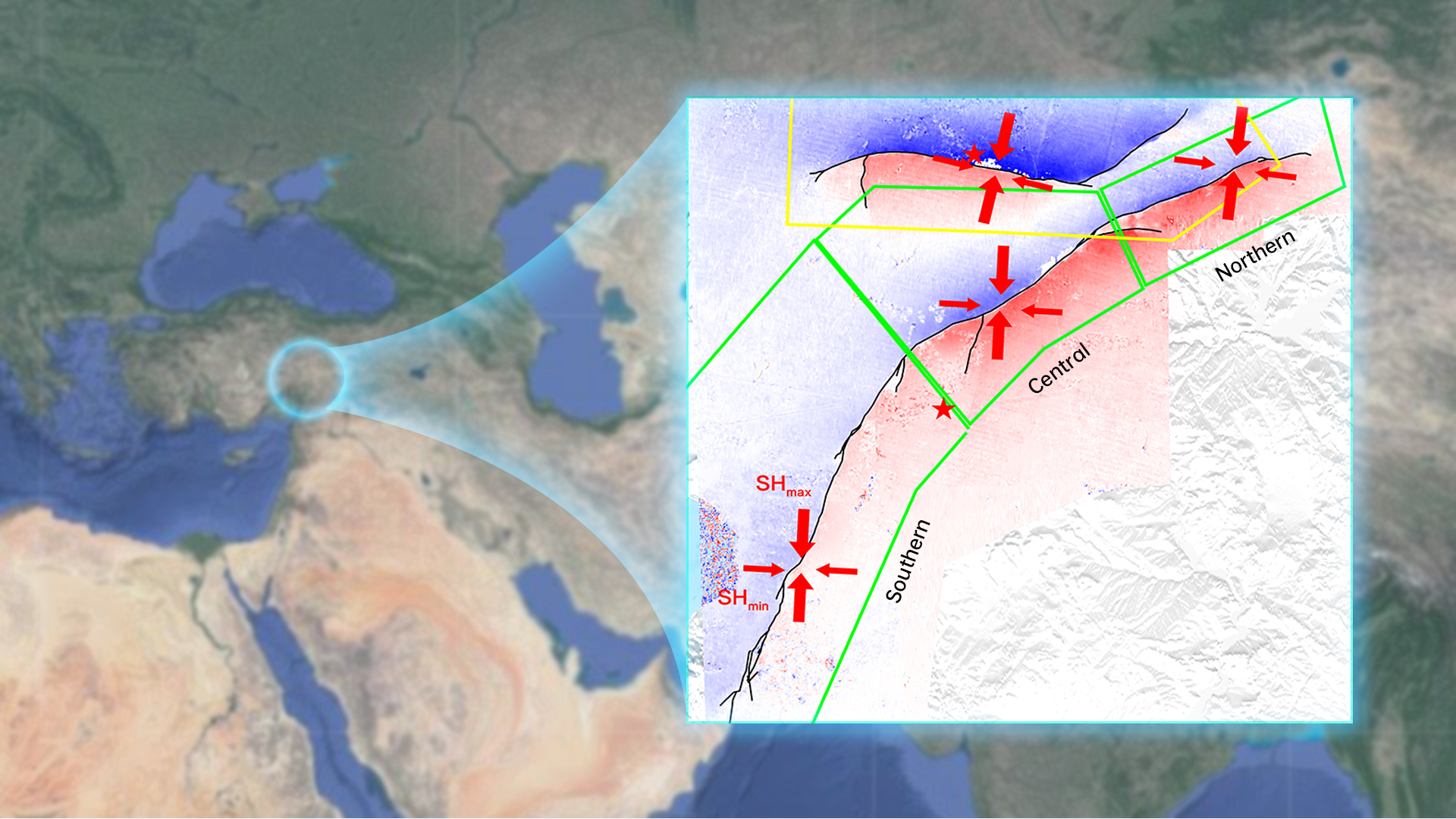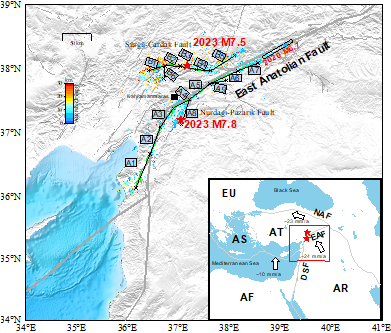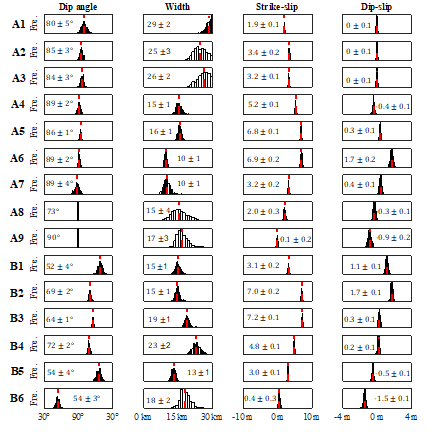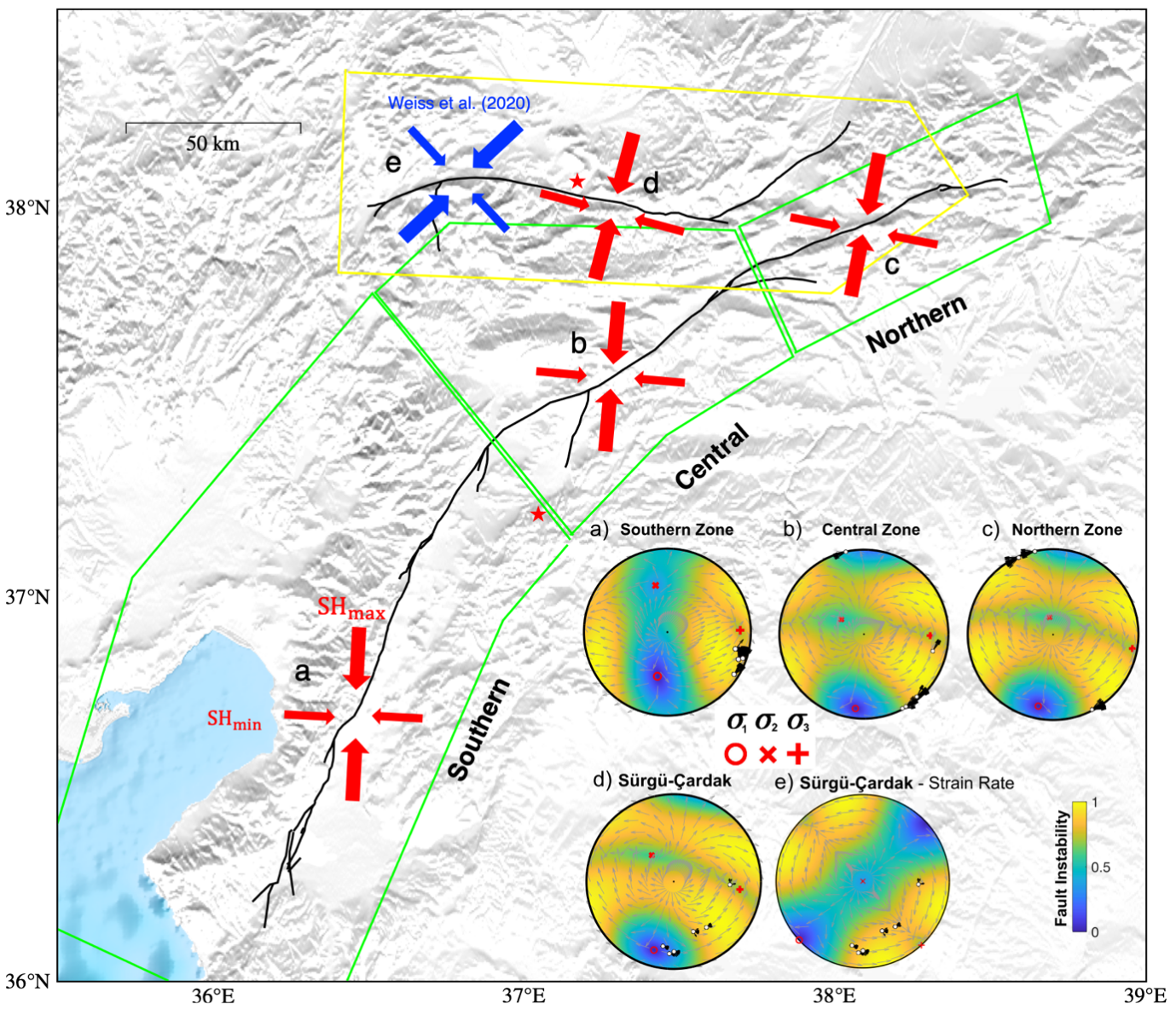As one of the most active strike-slip faults in the Mediterranean region, the East Anatolian Fault (EAF) has a history of frequent large earthquakes. It is well known that the EAF has a complex geometry, including bends, steps, and subsidiary parallel faults. Particularly in southern Turkey, it connects with the Dead Sea Fault (DSF) at the triple junction between the Arabian, African, and Anatolian plates (see Figure 1). Due to the difficulty of rupture propagation along complex faults, historical large earthquakes in this region have often been limited to relatively straight segments of the EAF.
Remote sensing imagery and field geological surveys show that the surface rupture traces of the M7.8 and M7.5 earthquake doublet in Turkey on February 6, 2023, exhibited unusual complexity. In particular, the M7.8 earthquake produced a surface rupture spanning 320 km with a bend of up to 44°, and the epicenter was located on the Nurdagi-Pazarik branch fault, separate from the main EAF fault. This raises the question of why the rupture was able to propagate across such complex fault structures.

A research team led by Associate Professor Kejie Chen from the Department of Earth and Space Sciences at the Southern University of Science and Technology (SUSTech), along with their collaborators, has published a study that analyzed the rupture processes of the M7.8 and M7.5 earthquakes in Turkey in 2023 and their relationship with pre-stress. It provides a new perspective for understanding the disaster mechanisms of destructive large earthquakes on faults with complex geometries.
Their paper, entitled “Super-shear ruptures steered by pre-stress heterogeneities during the 2023 Kahramanmaraş earthquake doublet”, has been published in the journal Nature Communications.

Figure 1. Tectonic setting of the 2023 M7.8 and M7.5 Kahramanmaraş earthquake doublet. Red stars indicate epicenters of the doublet. The blue star denotes the epicenter of the 2020 M6.7 event. In this study, the M7.8 rupture is divided into 9 planar sub-faults (A1–A9) and the M7.5 earthquake event into 6 planar sub-faults (B1–B6). The green lines represent the surface rupture traces. The locations of aftershocks for the first 20 and 26 days are color-coded with depth. The inset map indicates major plate boundaries and plate velocities relative to Eurasia. AF Africa, AR Arabia, AS Aegean Sea, AT Anatolia, EU Eurasia, DSF Dead Sea Fault, EAF East Anatolian Fault, NAF North Anatolian Fault.
Earthquakes are essentially the accumulation and release of stress within the Earth’s crust. Therefore, the researchers reconstructed the spatiotemporal process of the Turkey earthquake doublet, inverted the regional pre-stress, and explored their interplay. Specifically, based on surface ruptures and synthetic aperture radar (SAR) co-seismic observations, they first determined the dip angles of the sub-faults through a full Bayesian inference (Figure 2).
Unlike previous studies that suggest the M7.5 earthquake occurred on steep faults, they found that the dip angles of fault segments B1, B5, and B6 of the M7.5 earthquake were only about 55°. Subsequently, through the joint inversion of high-rate GNSS, strong-motion waveforms, and GNSS static displacements, they derived the slip distribution and rupture velocity of different faults. The M7.8 earthquake released energy of approximately 7.78×10²⁰ Nm within 75 seconds, with a maximum slip of about 11 m and an average rupture velocity between 3.0-4.0 km/s. However, the data could not confirm whether the M7.8 earthquake exhibited super-shear characteristics.
The rupture velocity of the M7.5 earthquake was well constrained by the observational data, showing a clear super-shear rupture, propagating approximately 40 km on both sides of the epicenter at a speed of about 5.0-6.0 km/s. This differs from previous studies that suggested super-shear rupture occurred only on the western side of the epicenter. Notably, while existing studies often discard data from the high-rate GNSS station EKZ1, located above the epicenter of the M7.5 earthquake, due to partial data interruption, the researchers included EKZ1 in the rupture velocity constraint, which may be one of the reasons for changes of rupture velocity estimates.

Figure 2. Posterior samples of geometric parameters based on Bayesian inference. The dashed red line marks the median of the samples for each parameter.
Using the focal mechanism solutions of 55 historical earthquakes, the research team estimated the pre-stress tensor of the earthquake doublet. They assumed that the slip direction was parallel to the direction of shear stress, thereby obtaining the normalized deviatoric stress tensor along three regions of the EAF (the southern region covering segments A1-A3, the central region covering segments A4, A5, and A8, and the northern region including segments A6, A7, and A9).
The results indicate that along the northeast-to-southwest rupture zone of the M7.8 earthquake, the principal stress (σ1) exhibited an approximately 20° counterclockwise rotation. Despite the fault’s overall strike changing by about 44° during the entire 320 km rupture of the M7.8 earthquake—from a nearly east-west strike in the northeastern region (segments A6 and A7) to a nearly southwest strike in the southwestern region (segments A1-A3)—the fault plane remained almost optimally aligned due to the rotation of the pre-stress field along the strike. Among these regions, fault instability was highest in the southern region, with an average value of 0.98, slightly decreasing to 0.85 in the northeastern region (Figure 3).

Figure 3. Pre-stress tensors and fault-slip data for different zones.
Compared to the M7.8 earthquake, the slip distribution of the M7.5 earthquake was more concentrated, resulting in a larger stress drop (approximately 11-21 MPa). Given that the Sürgü-Çardak fault, where the M7.5 earthquake occurred, was highly oblique to the East Anatolian plate fault, the occurrence of a large stress drop and supershear rupture was unexpected. This suggests that the local stress field of the Sürgü-Çardak fault may be inconsistent with the regional pre-stress field.
The stress tensor inversion results indicated that the principal stress (σ1) formed an angle of about 60° with the Sürgü-Çardak fault, showing a lack of alignment between the two (Figure 3d). However, there are only six historical earthquakes along the Sürgü-Çardak fault, which may not be sufficient to robustly constrain the stress tensor. The principal strain rate field, estimated from the crustal velocity field based on InSAR time series and GNSS data from 2014-2019, showed a rotation of up to 30° from the northeastern region of the M7.8 rupture on the EAF (segments A6, A7, and A9) to the region around Sürgü-Çardak. Most of the Sürgü-Çardak fault (segments B2 to B4) was only about 34° away from this rotation. Under such a stress state, the majority of the faults that ruptured during the M7.5 earthquake were favorably aligned for failure (Figure 3e). In summary, significant spatial heterogeneity of pre-stress (a 30° rotation over a distance of 25 km) exists in this region, but it is unclear what mechanism could cause such a large rotation of stresses.
The results of this study indicate that despite the complex fault geometry, the Turkey earthquake doublet developed into the largest continental strike-slip earthquake and doublet sequence recorded to date, driven by the spatial variation in pre-stress orientation. Similar to the 2008 M8.0 Wenchuan earthquake in China, the Turkey earthquake doublet caused massive casualties and economic losses. Both the Turkey earthquake doublet and the 2008 M8.0 Wenchuan earthquake occurred in typical seismic belts of the Mediterranean and the Himalayas, respectively. This study of continental strike-slip earthquakes in this paper also provides a reference for better understanding seismic activity and the preparation of major earthquakes around the Tibetan Plateau in China.
Associate Professor Kejie Chen is the first and corresponding author of the paper, with SUSTech as the first affiliated unit. Ph.D. student Guoguang Wei is the second author. Other collaborators include postdoctoral researcher Christopher Milliner and Professor Jean-Philippe Avouac from the California Institute of Technology, Assistant Professor Luca Dal Zilio from Nanyang Technological University, and Assistant Professor Cunren Liang from Peking University.
Paper link: https://www.nature.com/articles/s41467-024-51446-y
To read all stories about SUSTech science, subscribe to the monthly SUSTech Newsletter.
Proofread ByAdrian Cremin, Yingying XIA
Photo ByDepartment of Earth and Space Sciences